Trying to decide between the 243 Winchester and 270 Winchester cartridges? Here’s what you need to know about them.
I think most hunters would agree that the 243 Winchester and 270 Winchester both fantastic cartridges for certain situations. While there is definitely some overlap in their capabilities, there are some major differences between the 243 vs 270 cartridges you should be aware of though.
Both are very popular and effective centerfire rifle cartridges, but important details about them unfortunately get overlooked or simply lost in the shuffle. With that in mind, it’s easy to see how many people get confused about the strengths and weaknesses of the 243 Winchester and 270 Winchester, particularly when discussing which cartridge is best for hunting particular animals under specific conditions.
In this article, I’m going to investigate the 243 vs 270 debate in detail and provide some insight into which cartridge is better suited for common hunting situations so you can make an informed decision on which one will work best for your individual needs as a hunter or shooter.
Before we get started, I have an administrative note for you.
Some of the links below are affiliate links. This means I will earn a small commission (at no extra cost to you) if you make a purchase. This helps support the blog and allows me to continue to create free content that’s useful to hunters like yourself. Thanks for your support.
Additionally, I recorded an entire podcast episode on this exact subject. If you’d rather listen than read, click the appropriate link below to listen to this episode on your preferred podcasting service.
243 vs 270 Podcast
Apple | Google | iHeart | Pandora | Spotify
History Of The 270 Winchester and 243 Winchester
As is the case with many other cartridges developed in the United States, the story of the .270 Winchester and the 243 Winchester starts with the .30-06 Springfield.
The US Army started looking for a new infantry service rifle and cartridge after being on the receiving end of a deadly demonstration of the capabilities of the revolutionary new Mauser rifle and 7mm Mauser cartridge in the hands of Spanish troops in Cuba during 1898.
They eventually chose the bolt action 1903 Springfield rifle chambered in the new .30-06 Springfield cartridge.
The new .30-06 Springfield was dimensionally extremely similar to the 7x57mm Mauser and it’s highly likely that the designers of the 30-06 based their cartridge design heavily on the revolutionary 7mm Mauser cartridge.
Some have even gone so far as to say that the 7mm Mauser is the parent to the less well known 30-03 Springfield as well as the legendary 30-06 Springfield.
Anyway, using smokeless powder to fire a 150 grain spitzer bullet at 2,700 feet per second (2,428 ft-lbs of energy), the .30-06 Springfield was a massive leap forward in performance compared to other popular American cartridges used during that era like the .45-70 Government.
Not surprisingly, the .30-06 Springfield was an almost instant success in the civilian market.
As is often the case with any well designed centerfire rifle cartridge (like the 7mm Mauser or the .30-30 Winchester for instance), wildcatters also quickly started modifying the .30-06 Springfield to accomplish a variety of different tasks.
Some gun designers necked up the .30-06 to develop bigger cartridges like the 338-06 and the .35 Whelen.
Others opted to neck down the .30-06 case to use smaller diameter bullets (like the .25-06 Remington and 280 Remington). This is what the folks at Winchester did when they modified the case to use .277″ instead of .308″ bullets. The result was the .270 Winchester cartridge, which they released in 1925 with the Winchester Model 54 rifle.
The original .270 Winchester load shot a 130 grain bullet at a velocity of 3,140 feet per second (2,846 ft-lbs of energy). This was an incredibly high velocity for the 1920s and was a tremendous speed improvement over the .30-06 Springfield, which was itself considered a very high velocity cartridge at the time.
If you’d like to learn how the .270 Winchester compares to its parent case in the .30-06, read the article below:
270 vs 30-06 Debate Settled Once And For All
Subsequent loadings for the cartridge have dropped the typical velocity with 130gr bullets down to about 3,060fps. Which is still a pretty fast loading, even today.
The .270 Winchester was not an immediate commercial success, but American hunters appreciated the flat shooting characteristics of the round and the fact that it was so effective on thin skinned game. The cartridge gradually became more and more popular, which was helped by Jack O’Connor and his famous affinity for the cartridge that he expressed in countless Outdoor Life articles over the years.
That’s not to say that the cartridge only became the incredibly popular because of O’Connor. While O’Connor did indeed love the .270 Winchester and used it extensively on hunts all over the world, it was far from the only cartridge he used. The .270 Winchester was also a good enough cartridge and filled a big enough niche that it probably would have been successful even without any help from Jack O’Connor.
The .270 Winchester is a bit of an oddity when it comes to bullet diameter though. Unlike all the other popular 7mm cartridges like the 7mm Mauser, 7mm-08, 7mm Remington Magnum and the .280 Remington that use .284″ bullets, the .270 Winchester uses .277″ bullets.
It’s unclear exactly why designers at Winchester decided to go with .277″ instead of .284″ bullets with the .270 Winchester. One theory is they choose that particular bullet size based on the obscure 6.8x57mm Chinese Mauser cartridge. It’s also possible they wanted to create a distinctly American bullet size and avoid the 6.5mm and 7mm bullets popular in Europe by building a new brand new bullet diameter 10% smaller than the one used in the .30-06 (.9 multiplied by .308 is .277).
Regardless of their exact reasons, the design team at Winchester went with a .277″ bullet diameter and the rest is history. Interestingly enough, while the .270 Winchester turned out to be a smashing commercial success for the company, .277″ bullets never really caught on.
The 270 Winchester Short Magnum (270 WSM) and the .270 Weatherby Magnum along with the newer 6.8 Remington SPC, 27 Nosler, and 6.8 Western are the only other mass produced cartridges that utilize bullets of that size.
Even so, the 270 Winchester remains an incredibly popular and effective big game hunting cartridge all over the world.
Now let’s talk about the 243 Winchester.
Like I mentioned previously, the .30-06 Springfield has been one of the most popular and effective hunting cartridges in North America ever since it first hit the civilian market in the early years of the 20th Century. Even though it also performed very well in the hands of American Soldiers and Marines in World War II, leaders in the military began looking for a replacement for the .30-06 after the war.
They eventually settled on the 7.62x51mm NATO round in the 1950s.
The original 7.62x51mm M80 ball load fired a .308″ 147 grain full metal jacket (FMJ) bullet at 2,750 feet per second (2,469 foot pounds of energy). The cartridge also had virtually the same ballistics as the original .30-06 Springfield military load (150 grain bullet at 2,700 feet per second), but the 7.62×51 achieved that same level of performance with a shorter case length (51mm vs 63mm) due to advances in powder technology that occurred after the development of the .30-06.
Winchester identified significant commercial potential for the new cartridge during the development process of the 7.62x51mm and introduced the extremely similar .308 Winchester cartridge for the civilian hunting and shooting markets in 1952. Since the new .308 Winchester essentially duplicated the performance of the .30-06 while using a smaller case, the new cartridge was understandably a big hit with many American hunters and shooters.
Just like how things happened with the 270 descending from the 30-06, wildcatters and gun designers started modifying the .308 Winchester to develop new and more specialized wildcat cartridges almost immediately after it hit the market.
Among others, the .260 Remington, 7mm-08 Remington, .338 Federal, and .358 Winchester are all descended from the .308 Winchester cartridge as designers necked the case up or down as necessary to shoot smaller or larger 6.5mm, 7mm, .33 caliber, or .35 caliber bullets respectively.
Experiments with necking down the .308 to shoot smaller diameter 6mm/.243″ bullets yielded one of the first cartridges descended from the .308 Winchester in 1955: the .243 Winchester.
By necking down the .308 case to shoot smaller caliber bullets, the designers of the .243 Winchester built a cartridge with a higher velocity, flatter trajectory, and less recoil than the .308 Winchester.
The new .243 Winchester really caught on with a segment of the hunting population that wanted a flat shooting and light recoiling rifle cartridge that was powerful enough to cleanly take big game like deer and pronghorn.
Capable of shooting heavy as well as light bullets with excellent accuracy, the .243 Winchester was also a great varmint hunting cartridge and successfully bridged the gap between traditional varmint cartridges of the day like the .22 Hornet and .220 Swift on one hand and popular big game hunting cartridges like the .270 Winchester and .30-06 Springfield on the other.
While the .243 Winchester was indeed a very well designed and very effective cartridge, there are plenty of good cartridges that don’t experience commercial success for one reason or another. Fortunately for the .243 Win, Field & Stream editor Warren Page extolled the virtues of the little 243 in his columns.
Similar to the effects of Jack O’Connor’s writings about the .270 Winchester at Outdoor Life, Page’s columns almost certainly helped drive demand for the .243 Winchester.
However, the .243 Winchester also got something of an unintended assist from Remington when they released the competing .244 Remington the same year Winchester released the .243. Designed by necking down a .257 Roberts case (itself a necked down 7x57mm Mauser) to .243 caliber, the .244 Remington had a small ballistic advantage over the .243 Winchester.
However, Big Green made the unfortunate initial decision (similar to what they did with so many otherwise well designed cartridges) to use a slower 1:12″ rifling twist in their .244 Remington rifles. These rifles performed very well with lighter bullets for use on smaller predators and varmints like coyotes, but they were unable to properly stabilize the longer 100gr bullets that were best suited for use on bigger game like deer and antelope.
Since Winchester produced their .243 rifles with a faster twist rate of 1:10″, they could accurately shoot heavier bullets in addition to lighter bullets and were thus significantly more versatile than the .244 Remington initially.
Remington renamed the .244 the 6mm Remington a few years later and started producing rifles with a faster 1:9 twist rate, but the damage had already been done and the .243 Winchester was already well established and had claimed the majority of the 6mm centerfire rifle market share.
That remains the case to this day, even with the introduction of more advanced 6mm cartridges like the 6mm Creedmoor.
270 vs 243 Cartridge Sizes
You can see differences between the 243 Winchester and 270 Winchester in the photos below.
First, the 243 Winchester is physically quite a bit smaller than the 270 Winchester.
Both cartridges have the same diameter case with a .473″ rim, but the 270 Winchester has a longer overall length and uses a longer case length than the 243 Winchester.
The 243 cartridge has an overall length of 2.71″ and uses a case 2.045″ long. The 270 Winchester has an overall length of 3.34″ and uses a 2.54″ long case.
That said, the 243 Winchester will easily fit in a short-action bolt action rifle while the longer 270 Winchester requires a larger standard or long action rifle.
For those reasons, the 270 Winchester has quite a bit more case capacity than the 243 Winchester.
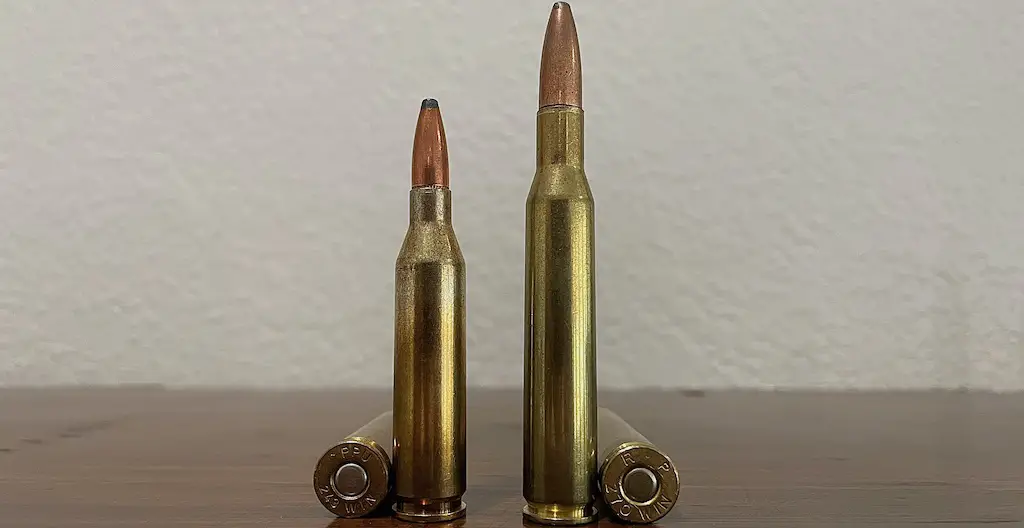
Bullet size and bullet weight are other important differences between the 243 vs 270 Winchester. The .270 Winchester uses .277″ diameter bullets while the 243 Winchester uses smaller .243″ bullets.
The .243 Winchester cartridge most often uses bullet weights in the 55-115 grain range, with 55, 87, 90, and 100 grain bullets being the most common.
On the other hand, the vast majority of 270 factory loads shoot bullets in the 130-160 grain range, with 130gr and 150gr grain bullets being the most common by far.
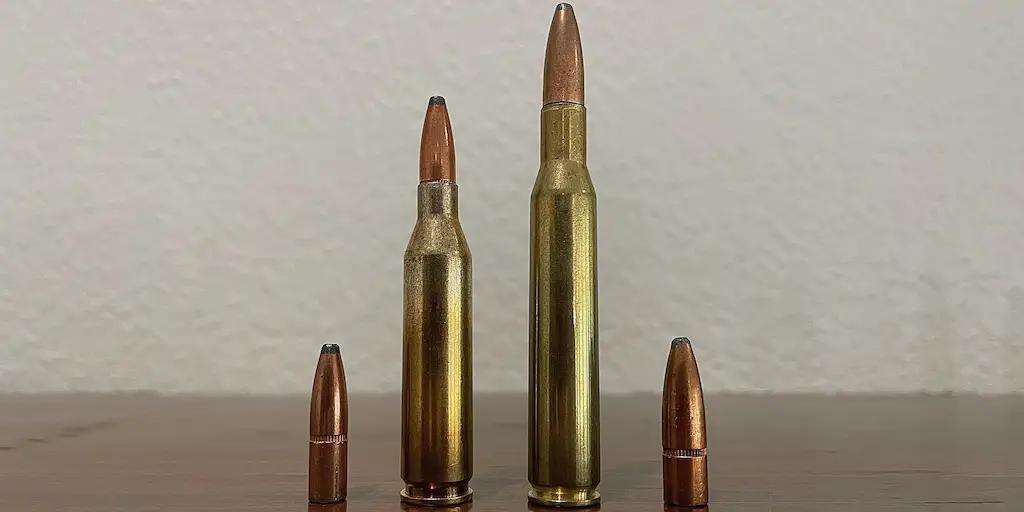
The 270 Winchester is also loaded to a higher SAAMI maximum average pressure of 65,000psi vs just 60,000psi for the 243 Winchester.
Note: while the powder capacity figures listed below do give a good indication of the differences between the two cartridges, exact case capacities vary slightly according to the brand of brass used.
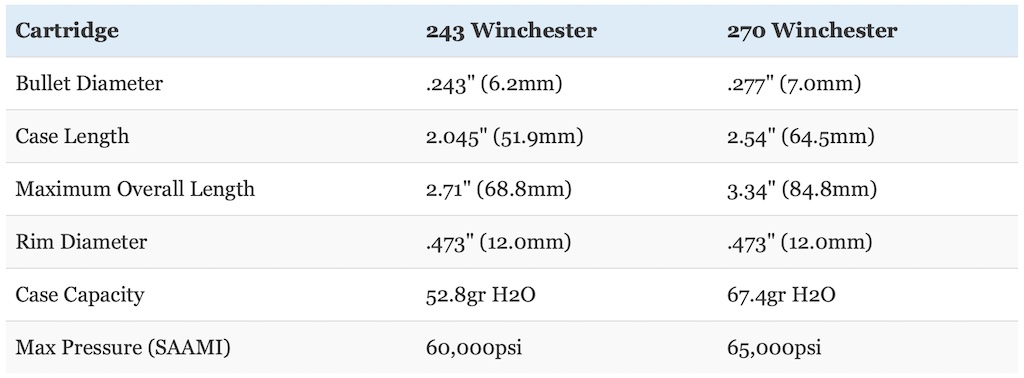
243 vs 270 Ballistics
The differences in the external dimensions of these cartridges also translate into some interesting differences in their ballistic performance. This is illustrated in the table below comparing Federal Power Shok, Hornady Precision Hunter, Nosler Trophy Grade, and Winchester Deer Season XP factory ammunition.
Specifically, the 243 Winchester loads use 80gr Power Shok (.365 BC), 90gr ELD-X (.409 BC), 95gr Extreme Point (.363 BC), and 100gr Partition (.384 BC) bullets.
The 270 Winchester loads use 130gr Power Shok (.372 BC), 130gr Extreme Point (.450 BC), 145gr ELD-X (.536 BC), and 150gr Partition (.465 BC) bullets.
Notice that the various bullets used in those 270 Winchester loads all have a higher BC than those used in the comparable 243 Winchester loads.
The Federal loads use light for caliber deer hunting bullets with a moderate BC, the Winchester loads use light to moderate for caliber bullets with a higher BC, the Hornady loads use heavier for caliber and exceptionally aerodynamic bullets with a very high BC, and the Nosler loads use the heaviest commonly available bullets available in factory loads for each cartridge.
The Winchester Deer Season XP loads are a little unusual because they use lighter bullets for the 270, but bullets on the heavier side for the 243 Winchester. That’s why I also included the Federal Power Shok loading (which uses a much lighter 80gr bullet for the 243 along with a 130gr bullet for the 270).
All eight loads used a 200 yard zero.
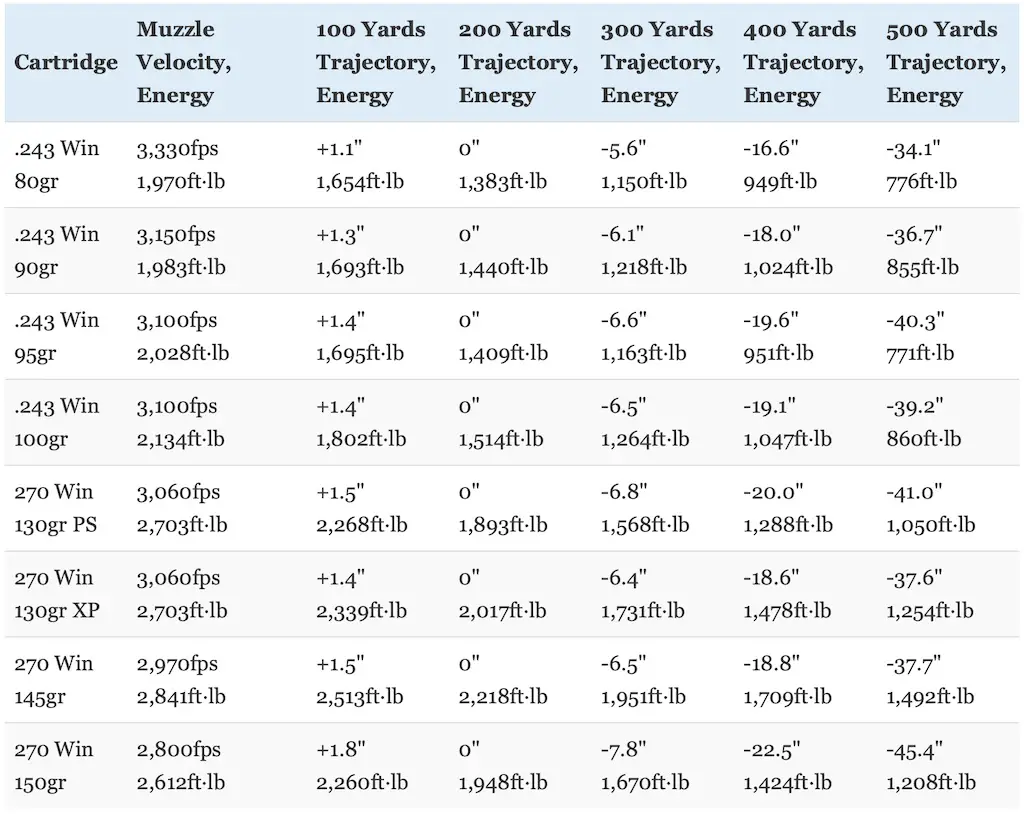
There is quite a bit of overlap with the trajectory of the two cartridges, but the lighter, higher velocity, and flatter shooting 80gr and 90gr 243 loads have a little bit less drop than the flatter shooting 270 loads.
Both the 243 and 270 Winchester are relatively flat shooting cartridges and they have very similar trajectories out to 500 yards. The differences are smaller at shorter range.
Just 3.5″ separates the flattest shooting 243 load from the flattest shooting 270 load at 500 yards. By the same token, 5.1″ separates the most arching 243 load from the most arching 270 load at the same distance.
At the same time, the 270 Winchester has significantly more kinetic energy than the 243 Winchester at all ranges.
The 270 Winchester starts out with 22-44% more muzzle energy than the various 243 Winchester loads. Since it uses a more aerodynamic bullet, that edge in kinetic energy grows as range increases to a 22-94% advantage in favor of the 270 depending on the exact loads compared.
All 4 243 loads dip below 1,500 ft-lbs of kinetic energy around 100-200 yards (with the 100gr Partition load dipping below that threshold just past 200 yards).
The Power Shok and Deer Season XP loads from the 243 Winchester both drop below 1,000 ft-lbs of energy just shy of 400 yards while the Precision Hunter and Nosler Partition loads both drop below that threshold before reaching 500 yards.
However, all 4 270 loads have more than 1,500ft-lbs of energy out past 300 yards and more than 1,000 ft-lbs of energy out past 500 yards.
Heck, that 145gr Precision Hunter load for the 270 Winchester has more retained energy at 500 yards than 3 of the 243 loads do at 200 yards!
So, the big takeaways so far are that the cartridges have a similar trajectory, with the 243 Winchester shooting a little bit flatter than the 270, but the 270 Winchester has a big edge in terms of kinetic energy.
The chart below compares how much a 10 mile per hour crosswind impacts those same 243 Winchester and 27o Winchester loads out to 500 yards.
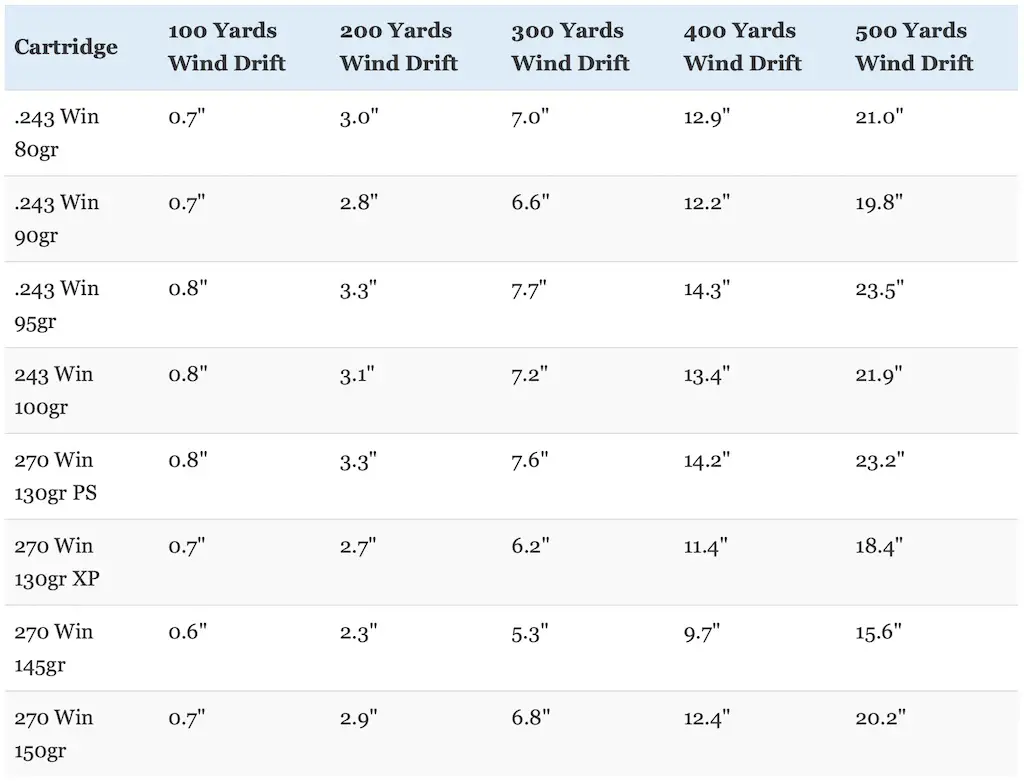
Once again, there’s a lot of overlap and both cartridges have somewhat similar amounts of wind deflection when using the same bullets, but the script flips and the 270 Winchester has the edge here.
While the 243 Winchester has a small edge in the trajectory department because it has a slightly faster muzzle velocity (40-530fps depending on the exact load), this advantage is mostly erased by the higher BC bullets used by the 270 Winchester.
Indeed, that super flat shooting, high velocity 80gr Power Shok load for the 243 Winchester is one of the worst performing loads in this category compared to the 270 Winchester. It does have a little bit less wind deflection than the 270 Winchester Power Shok load, but that’s the only 270 load it has less wind drift than.
Indeed, this is an area where the 270 Winchester performs well compared to the 243 Winchester since it uses higher BC bullets.
This is in contrast to the 243 Winchester which is a slightly higher velocity cartridge that’s typically loaded with lighter bullets with a lower BC that don’t retain energy or resist wind deflection as well.
Aside from the 90gr ELD-X, all the bullets used by the 243 Winchester in this comparison have a fairly low BC below .400.
With all that said, the differences between the 243 Winchester and 270 Winchester are definitely smaller at shorter range. The 270 still has less wind deflection at 100-300 yards, but the it’s not nearly as large of a contrast.
Now let’s talk about recoil.
The table below compares the recoil produced by handloads that approximate the performance of the Nosler factory loads above firing 100gr and 150gr Partition bullets for the 243 Winchester and 270 Winchester respectively when fired from identical 7 pound rifles.
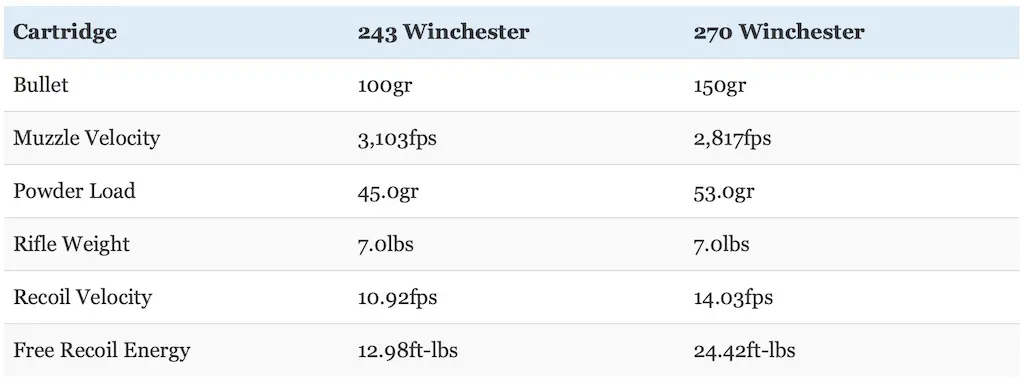
Felt recoil will vary from shooter to shooter and rifle to rifle, but free recoil energy is still a useful way to compare cartridges.
As you can see, the 243 Winchester has significantly less recoil than the 270 Winchester.
In fact, the 270 Winchester has approximately twice as much recoil! That’s really saying something too because the 270 Winchester isn’t a terrible recoiling cartridge itself.
All things considered, most hunters should be able to handle recoil from the 270 Winchester without too much trouble. The 243 Winchester just has an extremely mild recoil.
So, the 243 Winchester has a big advantage in this respect, especially for smaller or recoil shy hunters.
Don’t underestimate the impact that recoil has on the ability of a person to shoot accurately either.
Some people do handle recoil better than others, but all other things being equal, they will absolutely shoot more accurately with a milder recoiling cartridge.
What about 243 vs 270 accuracy?
The .243 Winchester is definitely capable of outstanding accuracy (often sub-MOA) in the right hands and when used in a quality rifle. The exceptionally mild recoil of the cartridge also helps immensely in that regard.
At shorter range, the cartridges are very evenly matched.
The .243 Winchester might has a small advantage due to the fact that the mild recoil and flatter trajectory of the cartridge no doubt help hunters place their shots in the right spot to a greater extent than the 270 Winchester.
Yes, I know I’m splitting hairs here.
The situation changes a little bit when shooting at long distances though.
While the 270 Winchester isn’t exactly a popular competition shooting cartridge, there is a bigger selection of high BC hunting bullets available for the cartridge. Those factors give the 270 Winchester an edge at longer range where battling environmental conditions (like resistance to wind drift in particular) becomes more important.
That’s not to say that the .243 isn’t accurate or that there aren’t a bunch of good quality bullets available for it. It’s just that the overall design of the 270 Winchester gives that cartridge an edge over the 243 Winchester in potential accuracy at extended range.
Additionally, there are a couple of other factors that are also worth discussing.
First, the 270 Winchester uses larger diameter bullets than the 243 Winchester.
Specifically, the larger diameter .277″ bullets used by the cartridge have about 30% more frontal surface area (also known as cross sectional area) than the .243″ bullets used by the 243 Winchester (.0603 vs .0464 square inches). All other things being equal, a bigger bullet will make a bigger hole, cause more tissue damage, and result in more blood loss.
This is a significant advantage in favor of the 270 Winchester, especially on bigger game.

Especially when combined with the fact that the 270 Winchester carries more kinetic energy downrange, those larger diameter bullets can also be helpful when hunting big game, especially deer or even potentially bigger game.
At the same time, the bullets used by the 270 Winchester usually have a higher ballistic coefficient than those used by the 243 Winchester.
Due to the constraints of the 1:10″ rifling twist most commonly used by 270 Winchester rifles, that cartridge cannot generally use super high BC bullets like other cartridges (like the 6.5 Creedmoor and 6.5 PRC).
Even so, there’s still a decent selection of high BC hunting bullets the cartridge can use (like the Hornady ELD-X, the Berger Hybrid Hunter, and the Nosler AccuBond Long Range).
Those aerodynamic projectiles don’t slow down as fast and are more resistant to wind drift.
For example, Federal, Hornady, and Nosler produce factory loads for the 270 Winchester using 130gr Swift Scirocco II (.450 BC), 140gr Berger Hybrid Hunter (.528 BC), 145gr ELD-X (.536 BC), and 150gr Nosler AccuBond Long Range (.591 BC) bullets.
Compare that to similar loadings from the same three companies for the 243 Winchester using 90gr Swift Scirocco II (.419 BC), 95gr Berger Hybrid Hunter (.434 BC), 90gr ELD-X (.409 BC), and 90gr Nosler AccuBond (.375 BC).
Note that Nosler makes the lower BC AccuBond bullet in 6mm, but NOT the higher BC AccuBond Long Range.
At the same time, the 270 Winchester also has an edge over the 243 Winchester in bullet sectional density.
Sectional density (SD) is a measure of the ratio of the diameter of a projectile to its mass.
All other things equal, a heavier bullet of a given caliber will be longer and therefore have a higher sectional density and consequently penetrate deeper than projectiles with a lower mass and sectional density.
As an example, 130 grain, 140 grain, and 150 grain .277″ bullets have sectional densities of .242, .261 and .279 respectively.
This compares favorably to 85 grain, 90 grain, and 100 grain .243″ bullets which have sectional densities of .206, .230, and .242 respectively.
While the heaviest .243″ caliber bullet does have the same SD as the lightest .277″ caliber bullet, the heavier .277″ bullets intended for use on bigger game (where bullet penetration is more important) far outclass those used by the 243 Winchester.
All things considered, the 270 Winchester is simply a significantly more powerful cartridge.
It’s not a super heavy hitter on the level of cartridges like the 7mm Rem Mag, the 300 Win Mag, the 28 Nosler, the 300 PRC, or even the 30-06, but it’s still in a completely different league from the 243 Winchester.
243 vs 270 Barrel Life
Neither cartridge is really known as a terrible barrel burner.
That said, the higher velocity and smaller bore 243 Winchester will probably have a shorter barrel life than the 270 Winchester.
Exact barrel life for each cartridge depends on a number of factors like the quality of the barrel, the exact ammunition used, etc.
The good news for hunters is that typical barrel life for even the 243 Winchester is more than enough to last for many years of hunting with no issues. Exactly when the barrel is unusable depends on the rifle as well as the hunter in question and what sort of performance they expect from their rifle.
Those who want extremely tight groups for long range shooting are probably going to want to change their barrel out sooner than those with slightly lower standards.
All other things being equal, the 270 Winchester will probably have a longer barrel life than the 243 Winchester, but the difference is probably not big enough for the average hunter to worry about unless they are putting a really large number of rounds downrange.
So where do we stand with each cartridge?
243 vs 270 Winchester
The 270 Winchester fires a larger diameter, heavier, and usually more aerodynamic bullet at a marginally slower velocity than the 243 Winchester. Therefore, the 270 has a slightly more arching trajectory, but more recoil, more resistance to wind drift, and carries significantly more kinetic energy downrange than the 243.
270 vs 243 Ammo
Both cartridges are extremely popular among hunters and shooters all over the world. Indeed, both are also likely in the Top 10 most popular centerfire rifle cartridges in the United States. While the 243 Winchester is extremely popular itself, the 270 Winchester is likely still the most widely used of the two.
That said, both are close in overall adoption, at least in the USA.
270 Winchester ammo also tends to be most common in ammo lines designed for deer hunting.
The big ammunition manufacturers like Barnes, Browning, Federal Premium, Hornady, Nosler, Remington, Sierra, Swift, and Winchester all produce a large variety of quality 270 Winchester factory ammunition suitable for hunting most species. In each case, there is normally a good selection of bullet types and weights for each cartridge suitable for big game hunting.
On the other hand, there’s a decent selection of both predator and varmint as well as big game hunting loads available for the 243 Winchester.
Most of this is big game and/or deer hunting ammo, like (among others) the Barnes VOR-TX, Federal Power Shok, Federal Fusion, Federal Non-Typical, Hornady American Whitetail, Hornady Precision Hunter, Nosler Trophy Grade, Remington Core Lokt, Winchester Super X, and Winchester Deer Season XP lines.
The 243 Winchester is also available in Hornady’s Superformance Varmint line, Nosler’s Varmageddon line, and Winchester’s Varmint X line.
While it’s often very easy to find a variety of ammo for both cartridges during normal times, ammo is usually a little easier to find for the 270 Winchester. In general, prices are similar for both, but 243 Winchester ammo may be a little less expensive.
During the 2020-2022 ammo shortage, the difference between the two cartridges has become even more apparent and (at least where I live and shop) 270 Winchester ammo is often easier to find and sometimes more reasonably priced than ammo for the 243 Winchester.
Ammo availability is also usually decent online and the bigger retailers typically have a good selection of quality factory ammo for both cartridges as well (but the 270 Winchester will likely still be easier to find, even online).
Bottom line: the average hunter will likely have easier access to ammo for the 270 Winchester than the 243 Winchester.
BUY SOME EXCELLENT 270 AMMO HERE
If you’d like to learn more about some of the various hunting ammunition choices for the 243 Winchester and 270 Winchester, read these articles:
Best 243 Ammo For Hunting Deer, Hogs, And Varmints
Best 270 Ammo For Hunting Deer, Hogs, And Other Big Game
Handloaders will appreciate the fact that reloading components for both cartridges are widely available and there’s an excellent variety of bullet choices for each cartridge. So, you should not have any trouble working up a good custom load for either one if you like to handload.
The .243 Winchester uses the same 6mm/.243″ bullet size as other 6mm cartridges like the 6mm Remington, the .240 Weatherby Magnum, and the 6mm Creedmoor.
The 270 Winchester uses the same .277″ bullet size as the 6.8 Remington SPC, 270 Winchester Short Magnum, 270 Weatherby Magnum, 27 Nosler, and the 6.8 Western.
270 vs 243 Rifles
Once again, the selection of rifles in 270 Winchester is probably a little better than is the case with the 243 Winchester. However, there’s a good selection of rifles chambered in both cartridges.
Both cartridges are extremely common in bolt-action rifles. In fact, just about every really popular bolt-action hunting rifle in current production is available in both cartridges.
For instance, both the .243 Winchester and 270 Winchester are available in several different versions of the Remington Model 700 and Winchester Model 70. The same goes for the Browning X-Bolt, Christensen Arms Mesa, Kimber Hunter, Mossberg Patriot, Remington Model 7, Ruger American, Ruger Hawkeye, Savage Axis, Savage 110, Tikka T3x, Weatherby Vanguard, and Winchester XPR.
While both cartridges are most common in bolt-action rifles, they’re also available in a few lever-action and semi-automatic models as well.
Both cartridges are available from Browning in their Browning Automatic Rifles (BAR) and Browning Lever Action Rifles (BLR).
Additionally, the 243 Winchester is also an option for those who prefer modern sporting rifles. In particular, while the cartridge is too long for use in an AR-15, it’s available in larger frame AR-10 platforms from companies like Wilson Combat.
The lever action Henry Long Ranger is also currently manufactured in 243 Winchester.
So, you can probably find a good deer rifle available in either cartridge regardless of the action type you prefer.
Additionally, barrel lengths do vary for both cartridges depending on the manufacturer and exact model.
The 243 Winchester is most common with a 22″ barrel length. 18″ and 20″ long barrels are not unusual though.
Many 270 Winchester rifles have 22″ barrels as well, but it’s also not unusual to see that cartridge in rifles with longer 24″ barrels.
Since it’s a short action cartridge, 243 Winchester rifles also often have a slightly shorter bolt throw and a shorter overall length.
For instance, the Winchester Model 70 Super Grade is available in both 243 Winchester and 270 Winchester.
The 243 Winchester version has a 22″ long barrel, is 42.25″ long overall, and weighs 7 pounds 12 ounces.
The 270 Winchester version of that same rifle has a 24″ long barrel, is 44.75″ long overall, and weighs 8 pounds 4 ounces.
Like I said, details vary depending on the exact manufacturer and rifle model in question. However, all things considered, rifles chambered in 270 Winchester tend to be slightly longer, heavier, and more unwieldy than rifles chambered in 243 Winchester.
Having a shorter and lighter rifle is more important on some hunts than on others. So, just keep that in mind.
If you’d like to learn more about some of the various hunting rifle choices for the 270 Winchester cartridge, read this article:
Best 270 Winchester Hunting Rifles
243 vs 270 Winchester: Which Is Right For You?
Do you primarily hunt medium sized game like whitetail deer and feral hogs (to include exotic game like Axis and Fallow Deer) at ranges within 200 yards? Both are outstanding deer hunting cartridges and will work on great deer sized game with good shot placement.
Indeed, a 243 Winchester shooting a 100 grain bullet and a 270 Winchester shooting a 130 grain bullet are both classic loads used by untold numbers of deer hunters over the years.
Go with the .243 if you’ll be primarily hunting game like deer or the 270 Winchester if you want something a little more versatile.
Additionally, if you’re going to be hunting in thick brush or in the tight confines of a deer stand, remember what I just mentioned about the size difference with 270 vs 243 rifles. That extra couple of inches in overall length of a rifle can be a real headache to deal with when trying to quickly and quietly maneuver for a shot. So, definitely consider the 243 Winchester if you’d prefer a more compact rifle.
Are you looking for a cartridge to hunt predators, varmints, and small game animals (like prairie dogs) with? The 270 Winchester will certainly work in this role and some people use it for predator hunting if that’s all they have or if they happen to encounter a coyote while deer hunting.
However, I think the .243 Winchester is the best choice here because it has a flatter trajectory (especially with lighter varmint bullets) and because there are many types of 243 ammo specifically designed for predator and varmint hunting.
Realize that while both are effective predator and varmint killers, the downside of both cartridges is that fur damage will likely be severe when using them. Use something like a 204 Ruger, a 22 Hornet, or a 223 Remington with dedicated varmint ammo to minimize this issue.
Are you looking for the cartridge better suited for long range hunting for game like mule deer or pronghorn antelope in open country where you might need to take a shot at longer ranges? The 270 Winchester is definitely the way to go here between these two cartridges because it carries so much more energy out to longer range and is more resistant to wind deflection.
The 243 Winchester will still work on deer sized game at longer ranges in the right hands, but I would not shoot past 300 yards on a deer or pronghorn with a run of the mill hunting bullet. I could potentially extend that to 300-400 yards or maybe even farther with a load using a high BC bullet (like the Hornady ELD-X) though.
It all depends on the conditions and the skill of the shooter though. If we’re being honest, most people don’t have any business shooting at game past 300 yards with either cartridge, but especially the little 243 Winchester.
Do you want a hunting cartridge that’s well suited for black bear, caribou, moose, elk, eland, kudu, or red stag hunting? The 270 Winchester is definitely a better choice than the 243 Winchester for this sort of hunting because it shoots larger diameter bullets that carry significantly more kinetic energy downrange.
While not often counted among the real “heavy hitters”, the 270 Winchester can be darn effective in this role when using heavy for caliber, controlled expansion bullets (like a 150gr Nosler Partition).
After all, lots of hunters have killed untold numbers of those animals with a .270 over the years. If anything, the .270 Winchester is even more effective on really large game (elk hunting in particular) now than it was even 20 years ago because hunters have access to much better quality bullets these days.
For instance, the 150gr Nosler Partition below really did a number on a big kudu bull in South Africa. The same hunter also used that particular rifle and loading to achieve one shot kills on blue wildebeest, zebra, and impala.
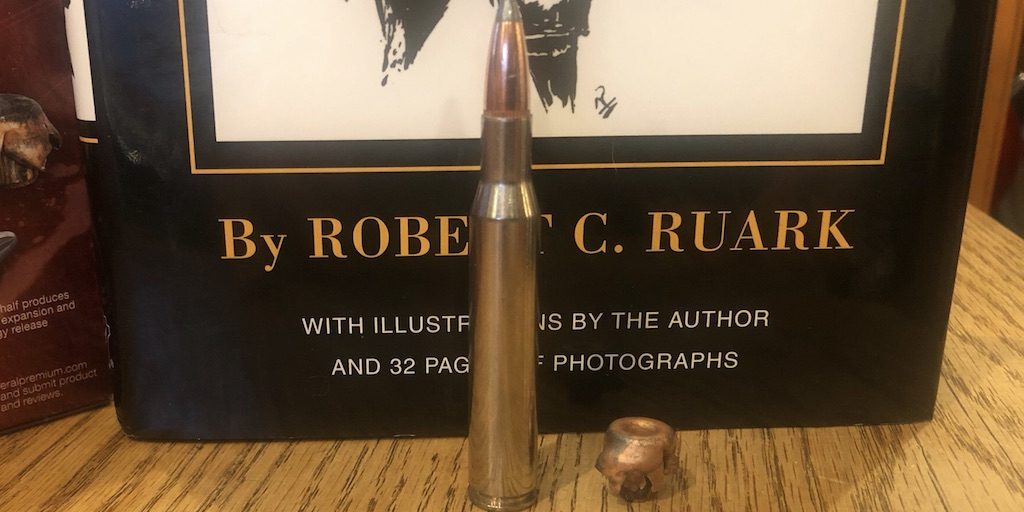
Yes, people can and do successfully hunt elk and moose with the 243 Winchester and it will definitely work in that role with the right bullets (like that 100gr Partition). However, your margin of error is much smaller with that cartridge and a responsible hunter should only use it on really big game at close range and when shooting angels are ideal (broadside, or very slightly quartering).
Realize that using the 243 Winchester on an elk or a moose hunt will require passing on a lot of shots that would be perfectly fine to take with a more powerful cartridge like the 300 Win Mag or even a 270 Winchester.
Are you sensitive to recoil and in need of a serious low recoil cartridge? Neither is a terrible recoiling cartridge, but the 243 Winchester has a big advantage over the 270 Winchester here.
Indeed, the 243 Winchester is an especially great choice as a centerfire rifle cartridge for a newer and/or recoil shy hunter. That cartridge is very “shootable” in a rifle that fits the hunter well, has a good recoil pad, and is equipped with either a suppressor or a muzzle brake.
It’s by no means limited to newer or smaller hunters either. Heck, it’s an outstanding choice for deer hunting and lots of veteran hunters use it on deer each year with great results.
As I’ve stated before: the 243 Winchester and 270 Winchester are both solid rifle cartridges. However, since the difference between them (243 vs 270) is pretty big in certain respects, each cartridge is better suited to specific situations than the other.
Carefully evaluate your needs as a hunter based upon the circumstances you foresee using the cartridge in, get a good hunting rifle chambered in the cartridge you select, learn to shoot it well, use quality bullets, and it should serve you well afield.
NEXT: BEST 6.5 CREEDMOOR AMMO FOR HUNTING ELK, DEER, & OTHER BIG GAME
NEXT: BEST GIFTS FOR HUNTERS
Enjoy this article comparing the 270 Winchester and 243 Winchester cartridges? Please share it with your friends on Facebook and Twitter.
The Lyman 50th Edition (p159-162 & p197-198) and Hornady 10th Edition (p231-237 and p351-355) reloading manuals were used as references for the history of the 243 vs 270 cartridges. I obtained the data used to compare the trajectory of the cartridges from Federal (here and here), Hornady (here and here), Nosler (here and here), and Winchester (here and here). Data used to calculate recoil was obtained from the Nosler 9th edition reloading manual (p202 & p342). Case capacity information for the 243 Winchester and 270 Winchester were obtained from Chuck Hawks (here). Maximum pressure and data to compare cartridge sizes for the 243 Winchester and 270 Winchester were obtained from SAAMI (p26 and p28). I used ShootersCalculator.com to compare trajectory and recoil for the cartridges.
Make sure you subscribe to The Big Game Hunting Podcast and follow The Big Game Hunting Blog on Facebook, Instagram, Twitter, and YouTube.
John McAdams is a proficient blogger, experienced shooter, and long time hunter who has pursued big game in 8 different countries on 3 separate continents. John graduated from the United States Military Academy at West Point and is a veteran of combat tours with the US Army in Iraq & Afghanistan. In addition to founding and writing for The Big Game Hunting Blog, John has written for outdoor publications like Bear Hunting Magazine, The Texas State Rifle Association newsletter, Texas Wildlife Magazine, & Wide Open Spaces. Learn more about John here, read some of John’s most popular articles, and be sure to subscribe to his show: the Big Game Hunting Podcast.


TY!! I find this article to be top notch. Answered my questions, as I am currently waffling. My go-to has been 30-06 RAIL-ROAD TIE( WEIGHT) Accurate, tack-driver. But, I am now 70 y.o. Looking for lighter/ less recoil. Debating Cascade vs Ruger SFAR.
Hey there! I simply want to give you a big thumbs up for the excellent information you have here on this post. I am coming back to your website for more soon.